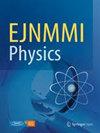欧洲原子能共同体-欧洲核医学会关于评估核医学病人外部剂量率的先进计算框架的联合倡议
IF 3
2区 医学
Q2 RADIOLOGY, NUCLEAR MEDICINE & MEDICAL IMAGING
引用次数: 0
摘要
为了确保对核医学(NM)患者附近的工作人员、护理人员和公众等关键群体进行充分的辐射防护,有必要考虑患者在住院期间或离开医院后所释放的辐射的影响。目前的风险评估基于在距离患者指定距离的单一位置测量环境剂量率,并在施用放射性药物后的多个时间点进行测量,以估算全身滞留量。本研究针对这种方法的局限性,开发并验证了一种更先进的计算剂量测定方法,该方法采用蒙特卡罗(MC)模拟,结合灵活逼真的计算模型和参考生物动力学模型的时间活动分布曲线。针对使用 99m锝-HDP/MDP、18FDG 和 Na131I 的典型临床程序,我们成功地将距离 NM 患者 1 米处的环境剂量率当量Ḣ*(10)测量结果与使用 ICRP 成人参考计算体素模型的 5 种不同代码的 MC 模拟结果进行了比较。所有测量数据都在平均模拟结果确定的 95% 置信区间内。此外,还对不同的 MC 代码(MCNP-X、PHITS、GATE、GEANT4、TRIPOLI-4®)进行了更真实的比较,在这种情况下,受照个体的有效剂量率Ė 是在正对着病人模型的 30 厘米、50 厘米和 100 厘米的位置和旁边测定的。对于 1 米处的所有放射性药物,不同编码之间的差异低于 8%,而对于 30 厘米和 50 厘米处的面对面和并排配置,不同编码之间的差异在 5% 到 16% 之间。一项关于患者模型形态影响的敏感性研究表明,在给药后 120 分钟内的时间点,1 米处的Ḣ*(10) 的相对标准偏差仍低于 16%。作为风险评估研究的一部分,经过验证的计算方法将进一步用于评估各种近距离接触配置和一系列放射性药物的单位给药活度有效剂量率。连同适当剂量限制的选择,这将有助于制定释放标准和患者限制。本文章由计算机程序翻译,如有差异,请以英文原文为准。
Joint EURADOS-EANM initiative for an advanced computational framework for the assessment of external dose rates from nuclear medicine patients
In order to ensure adequate radiation protection of critical groups such as staff, caregivers and the general public coming into proximity of nuclear medicine (NM) patients, it is necessary to consider the impact of the radiation emitted by the patients during their stay at the hospital or after leaving the hospital. Current risk assessments are based on ambient dose rate measurements in a single position at a specified distance from the patient and carried out at several time points after administration of the radiopharmaceutical to estimate the whole-body retention. The limitations of such an approach are addressed in this study by developing and validating a more advanced computational dosimetry approach using Monte Carlo (MC) simulations in combination with flexible and realistic computational phantoms and time activity distribution curves from reference biokinetic models. Measurements of the ambient dose rate equivalent Ḣ*(10) at 1 m from the NM patient have been successfully compared against MC simulations with 5 different codes using the ICRP adult reference computational voxel phantoms, for typical clinical procedures with 99mTc-HDP/MDP, 18FDG and Na131I. All measurement data fall in the 95% confidence intervals, determined for the average simulated results. Moreover, the different MC codes (MCNP-X, PHITS, GATE, GEANT4, TRIPOLI-4®) have been compared for a more realistic scenario where the effective dose rate Ė of an exposed individual was determined in positions facing and aside the patient model at 30 cm, 50 cm and 100 cm. The variation between codes was lower than 8% for all the radiopharmaceuticals at 1 m, and varied from 5 to 16% for the face-to face and side-by-side configuration at 30 cm and 50 cm. A sensitivity study on the influence of patient model morphology demonstrated that the relative standard deviation of Ḣ*(10) at 1 m for the range of included patient models remained under 16% for time points up to 120 min post administration. The validated computational approach will be further used for the evaluation of effective dose rates per unit administered activity for a variety of close-contact configurations and a range of radiopharmaceuticals as part of risk assessment studies. Together with the choice of appropriate dose constraints this would facilitate the setting of release criteria and patient restrictions.
求助全文
通过发布文献求助,成功后即可免费获取论文全文。
去求助
来源期刊

EJNMMI Physics
Physics and Astronomy-Radiation
CiteScore
6.70
自引率
10.00%
发文量
78
审稿时长
13 weeks
期刊介绍:
EJNMMI Physics is an international platform for scientists, users and adopters of nuclear medicine with a particular interest in physics matters. As a companion journal to the European Journal of Nuclear Medicine and Molecular Imaging, this journal has a multi-disciplinary approach and welcomes original materials and studies with a focus on applied physics and mathematics as well as imaging systems engineering and prototyping in nuclear medicine. This includes physics-driven approaches or algorithms supported by physics that foster early clinical adoption of nuclear medicine imaging and therapy.
 求助内容:
求助内容: 应助结果提醒方式:
应助结果提醒方式:


